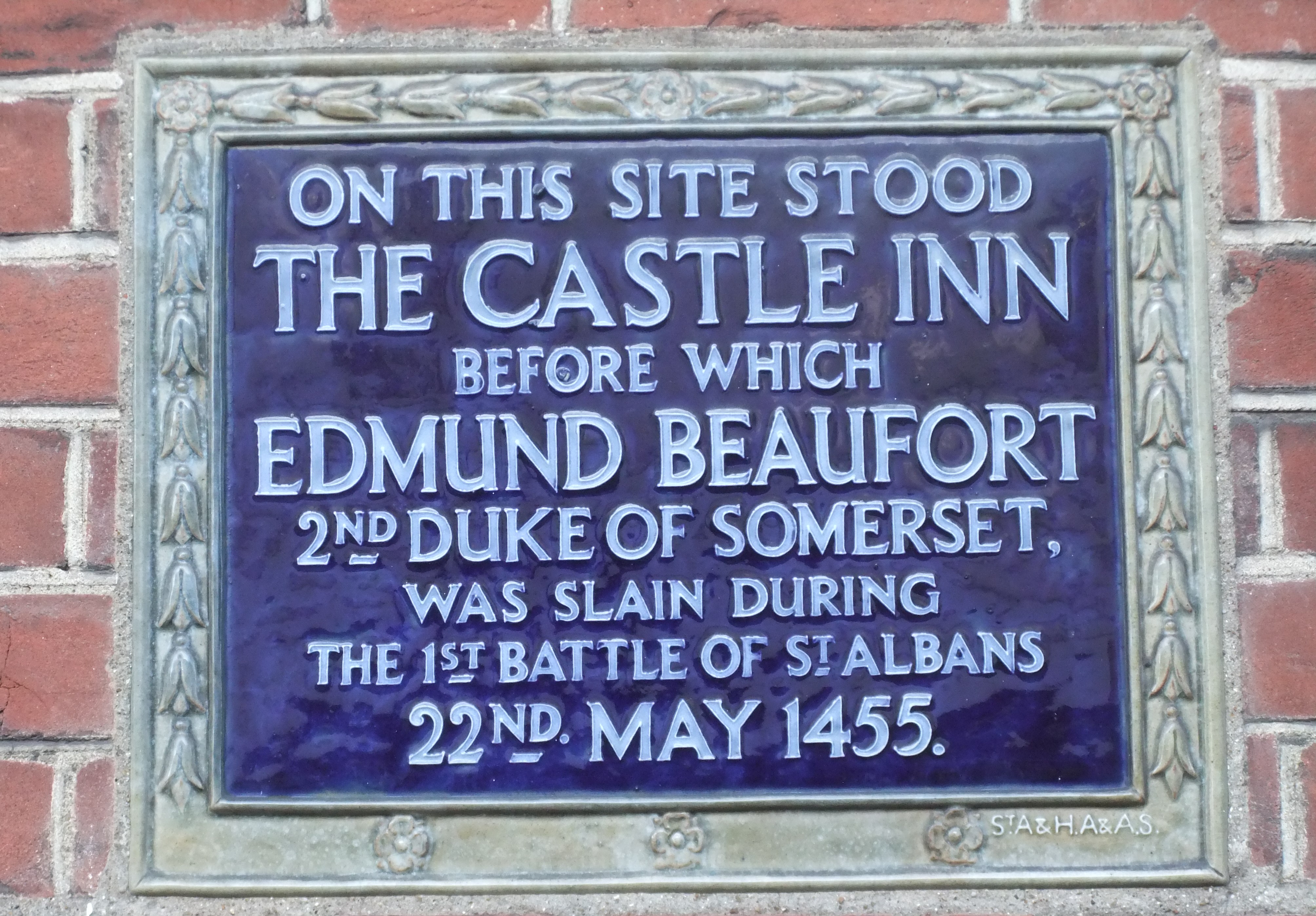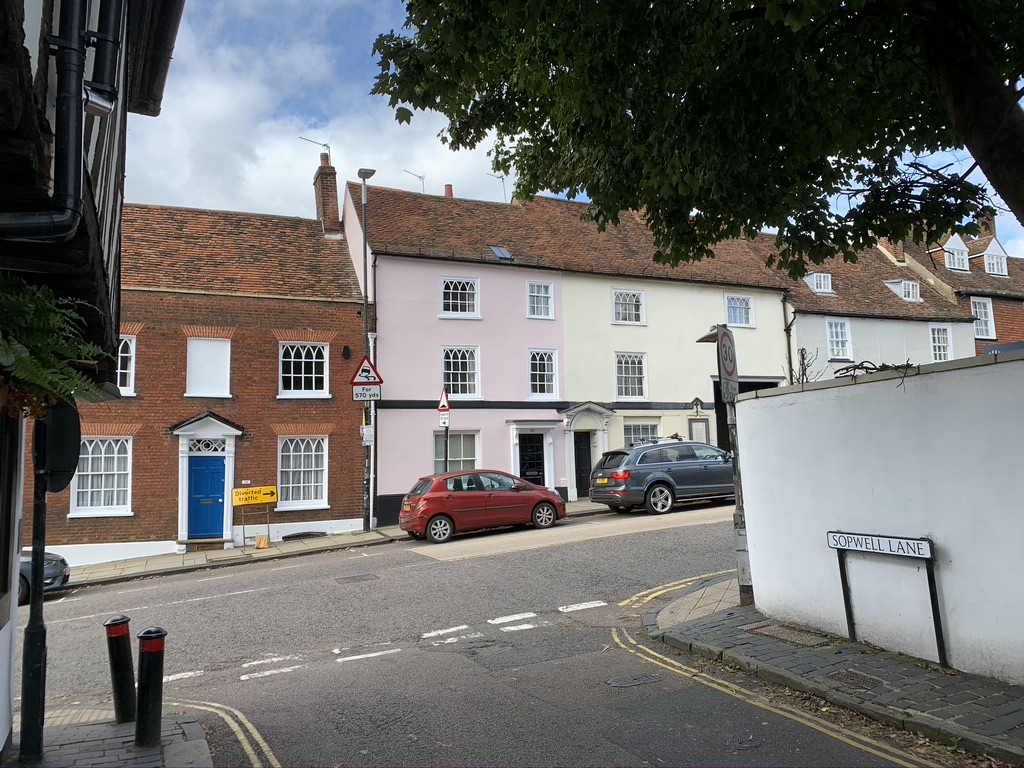On the 22nd May 1455, the first battle in what would become known as The War of the Roses took place in the centre of St Albans. Drawing on recent research, Dr John Morewood, SAHAAS President, looks at the background to the conflict, what happened on the day, and the places in the city connected with the battle.

Society plaque commemorating site where Edmund Beaufort, Duke of Somerset, was slain [SAHAAS]
The whole place filled with corpses of the slain.
This is how Abbot John of Wheathampstead described the centre of St Albans after the battle of Thursday 22 May 1455.
Acknowledging the sensitivities of the good abbot, as battles go in the feud between the Houses of Lancaster and York, the numbers involved were small: 2,000 – 2,500 Lancastrians opposed by 3,000 Yorkists. The numbers killed were also small – perhaps 100 or slightly more.
So, we might wonder why in May 2021 the Royal Mail commemorated the event on the highest value stamp in its new set featuring Wars of the Roses’ battles and ignored the Second Battle of St Albans in 1461 which involved much greater numbers. Of course, the 1455 battle is traditionally seen as the beginning of the struggle, but is there more to it than that?
High ranking casualties
Although the numbers killed were comparatively small, they included a suspiciously high proportion of high-status individuals. Traditionally, the battle is seen as an attempt by Richard Duke of York to remove from power his arch-rival, the Duke of Somerset. After negotiations failed, the fighting began.
The Yorkists attempted to break into the town through the barricades which blocked what is now Sopwell Lane, Victoria Street and Hatfield Road and which were manned by their Lancastrian opponents. These attempts failed. Only when the Earl of Warwick’s forces launched an attack through the back gardens and attacked the Lancastrians in the rear was progress made.
Devastating archers
Emerging approximately where Bill’s restaurant is now in Chequer Street, 600 archers were deployed with devastating results. Many Lancastrians were not fully armed and the King, Henry VI, himself was wounded – ironically close to what is now Boots on St Peter’s Street.
But it was not the shedding of royal blood – it may have been merely a scratch from a spent arrow – that makes the battle important. Nor indeed was it the killing of York’s rival, Somerset, outside the Castle Inn (the site now occupied by the Skipton Building Society or Connells Estate Agents – opinions vary).
The powerful Neville family
Most of York’s troops belonged to the powerful Neville family who had been engaged in a bitter struggle with the Percys for domination of the north of England.
Supporters of both families attacked each other’s manors and in 1453 the Percys tried to assassinate the leading Neville, the Earl of Salisbury, as he returned from his son’s wedding. The Percy head, the Earl of Northumberland, a leading Lancastrian, was at St Albans on 22nd May, as were many of his northern supporters.

Sopwell Lane, defended by the Lancastrians [Peter Bourton]
Certainly, by early afternoon not only was Somerset dead, so too were Northumberland and many of his supporters. Few prisoners seem to have been taken and this vendetta left a legacy. The families of the slain sought revenge.
They would have to bide their time but the events of 22nd May 1455 in St Albans’ set the tone for a bitter conflict that did not end until the Battle of Stoke Field in 1487. This also makes the battle worthy of remembrance.
| City locations | Significance |
| Bill’s, Chequer Street | Presumed site of Warwick’s breakthrough. |
| The Boot Inn, Market Place | Battlefield Trust Interpretation panel. Not a pub in 1455 but parts are contemporary with the battle. |
| The Clock Tower | The bell was rung to warn of the Yorkist advance. |
| Keyfield Terrace Car Park | Site of the Yorkist assembly point. |
| St Albans Museum + Gallery | Good interpretation of the battle. |
| Skipton Building Society, St Peter’s Street | SAHAAS plaque commemorating the Duke of Somerset. |
| St Peter’s Church | Burial place of many of the combatants. |
| St Peter’s Street | Site of most casualties. |
| Sopwell Lane | Defended by the Lancastrians. |
We are grateful to Matt Adams, Group Editor, for permission to reproduce this article, which first appeared in the Herts Advertiser.




